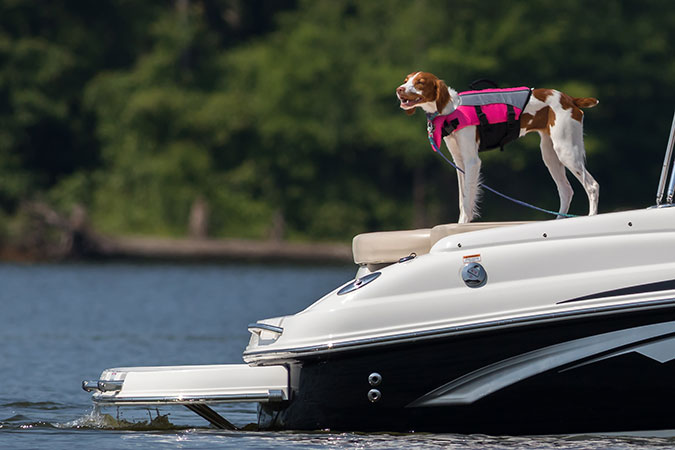Boating With Dogs

Summertime means days spent on the lake in a boat soaking up the sunshine and cruising around in the water. If you have a dog, you may want to take them along with you! However, there are a few things you need to do before you take your dog along to ensure a fun, smooth, and safe ride.
Dog Boating Etiquette
Before your first time on the water with your four-legged friend, it's a good idea to do a few things to prepare your pet as well as yourself for what's in store.
It's a good idea to allow your pet onto the boat ahead of time if possible so that they can have a chance to explore and get familiar with everything before you're out on the water. You also may want to start the motor and see how your dog reacts. Are they scared? Do they want to get off the boat? If they're still doing alright, you might also want to consider doing a quick "test ride" and driving the boat around slowly. A little bit of nerves are normal, but if your dog is panicking or causing any disruption, it may be a better idea to leave them on shore during your next outing.
After allowing your dog a bit of time to get used to the boat, you'll next want to teach them how to get in and out of the boat safely. If you have a small dog, it's easiest to simply carry them onto your watercraft. However, larger dogs will need to climb on by themselves. Some dogs may be nervous to step onto a floating surface. Steps or ramps can be helpful for pups who are a little hesitant or may need a little extra help. A good trick to teaching your dog how to get on and off the boat is by luring them with a treat. Hold a yummy treat in your fist in front of your dog's nose as you slowly walk into the boat and encourage your dog to follow. Remember to never force your dog onto the boat.
The next thing you'll want to do is teach your dog to "go to place." Why is this important? If your dog is running around the boat while you're cruising at a high speed or hit any rough waters, there may be a greater risk of injury or accidents. Having a specific place for your dog to sit will allow them to have a safe spot, which is especially helpful if they are a little nervous to be out on the water in the first place. You can train your dog to go to his spot the same way you trained them to get on and off the boat, by luring them with a treat and adding a verbal command along with it.
Next, teach your dog to come when called if this is something they don't already know how to do. Be sure you practice doing this in the water too, while your dog is swimming. A good way to do this is by playing fetch with your dog in the water and calling them back to you after they retrieve their toy. Of course, you'll need a floating fetch toy, like Chuckit!'s Amphibious Toys, to do this. Don't use a toy that will sink.
Last of all, you'll want to be sure you have a plan in place for when your dog needs to use the bathroom! One option is to keep some potty pads on board for your dog to use while on the boat. However, a better option if possible is taking some breaks and heading to shore so your dog can do their business. Be sure you have a leash handy as well as some waste bags so that you can be sure you're picking up after your pup.
Dog Boating Safety & Gear

Once you're feeling confident that you and your dog are ready for a day on the boat, you'll want to make sure you're stocked up on some other items you'll need to ensure safety. Here are a few items that are good to bring along on the boat:
- Dog Sunscreen – Did you know that dogs can get sunburned? Be sure you bring some dog-friendly sunscreen along on the boat with you and apply it to their exposed areas (such as their nose) before you get into the sun! Make sure your dog has access to a shady spot as well.
- Portable Water Bowl – Don't let your dog get dehydrated! Bring plenty of fresh water with you along with a travel water bowl so that your dog has easy access to fresh, clean water.
- Pet First Aid Kit – You may also want to get a pet-specific first aid kit in case of an emergency. Be sure you keep it stocked with items such as ointments, tweezers, a flashlight, and any kind of medications your dog may need while out on the water.
- Dog Life Jacket – Last but certainly not least, you'll need to make sure your dog has a properly fitting life jacket. while most dogs can swim, they must have a life jacket in case they fall overboard or in case of an emergency. Make sure you do your research so that you find something that suits your dog's size and breed. May dog life jackets have handles that make it easier for you to pull your dog out of the water. Before you head out, be sure you test out your dog's jacket in shallow water so that you can ensure it fits properly in deeper water.
If you've always wanted a boat dog and adventure buddy while you're out on the water, be sure you put in the work needed to train them to behave appropriately as well as invest in the necessary gear! having a dog as a boating companion can add plenty of fun to all of your boating adventures!
Previous article

Next article

Related posts
View all-

Wet Vs. Dry Cat Food: Which is Better?
As a caring cat owner, you always want the best for your furry friend, especially with their food. You typically have two choices: dry cat food in a bag or canned wet food. Whether you've just brought home a new kitty or are looking to transition to a new food, the decision process can be overwhelming, and understanding the impact of each on your cat's diet is essential. Read Article -

Celebrate National Pet Week: Fun Ideas to Celebrate with Your Pet
National Pet Week is right around the corner, so it's time to plan how you're going to celebrate! While we're sure you celebrate your pet all day every day... Read Article -

5 Simple Tips to Make Sure Your Cat Drinks Enough Water
Ensuring your cat stays hydrated is important, but it can be challenging since many cats don't drink enough water. Dehydration can lead to kidney disease and other health issues. Fortunately, you can encourage your cat to drink more with a few simple changes. Read Article



